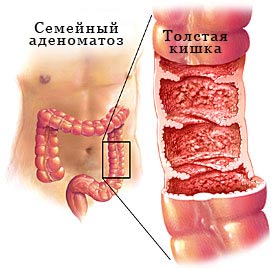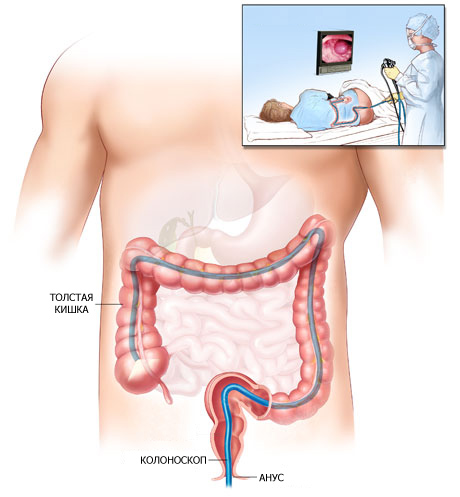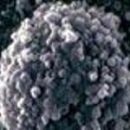What is polyposis? Why he arises as manifests as he is treated? Find out in this article.
Content
Tumor
Tumor — This pathological process, presented by a newly formed tissue, in which changes in the cell genetic apparatus lead to a violation of the regulation of their growth and differentiation. By the nature of the growth of the tumor are divided into benign and malignant.
Determination of the disease Family adenomatosis of colon
Family adenomatosis of the colon is characterized by the development of a large number of adenomes (from 100 to several thousand) on the mucous membrane of the colon with progressive growth and mandatory malignation in the absence of timely treatment. The disease is inherited and can be detected from several family members and the closest relatives in several generations. The overwhelming majority of researchers rightly believes that cancer (adenocarcinoma) of thick (straight and colon) intestines in the overwhelming majority of cases increases from a benign polypa (adenoma).
Causes of family adenomatosis colon
It was established that the development of adenomatosis of the colon is due to the mutation of the gene responsible for the normal proliferation of the mucous membrane of the gastrointestinal tract. Mutation of the gene can be inherited regardless of gender. At the birth of a child, signs of illness are not clinically manifested. In the future, as the organism grows, the appearance of small polyps on the fat intestine mucosa.
Polyps with adenomatosis of the colon can be represented by adenoma of various or the same type: small iron polyps with a leg or without it, large polyps more than 1 cm in diameter with a pillable or porcedular surface, polyps have a long leg or wide base. Against the background of polyposis with small polyps, cancer tumors are detected in 30% of cases.
Manifestations of family adenomatosis colon
Clinical manifestations of the disease appear most often aged 15-19 years. The most frequent and permanent symptoms are: a rapid chair (up to 5-6 times a day), blood release from the rear passage and abdominal pain.
 Blood sections from the rear pass usually has the character of impurities to a liquid or semi-mounted calor. Profuses of bleeding are observed very rarely. Student defecation, blend of blood and mucus, liquid callers are often regarded as symptoms of dysentery, and patients are hospitalized in infectious hospitals. This happens with each fifth, suffering from family adenomatosis.
Blood sections from the rear pass usually has the character of impurities to a liquid or semi-mounted calor. Profuses of bleeding are observed very rarely. Student defecation, blend of blood and mucus, liquid callers are often regarded as symptoms of dysentery, and patients are hospitalized in infectious hospitals. This happens with each fifth, suffering from family adenomatosis.
Abdominal pain — frequent symptom of the disease, the localization of it, the intensity and the time of appearance may be different. Often when treating a patient about abdominal pain The doctors focus on the study of only the upper departments of the gastrointestinal tract, especially since this group of patients often complains of gastric discomfort. In the later stages of illness, pain is mainly due to the development of cancer.
Such symptoms of the disease, as fatigue, general weakness, anemia, most often begin to manifest themselves by 20 years. At this age, the number and size of polyps increase, large polyps of a vigilant nature appear, the blood loss increases from the intestine. Changes in absorption and secretion in the colon lead to pronounced metabolic disorders. In most patients, it coincides with time with an increase in load: the beginning of work, the service in the army, in women — Pregnancy and childbirth.
With the development of cancer from polyps, the general condition of the patients is exacerbated and new symptoms appear: a sharp pallor of the skin due to pronounced anemia, sometimes an increase in body temperature, periodic severe pain in the abdomen and signs of intestinal obstruction.
Many years of experience in observing and treating patients with family adenomatosis allowed me to identify some features of the clinical course of the disease and allocate three main options: classical, heavy and weakened, or attenuated, forms.
The classic form of the course of the disease occurs most often (more than 70% of the surveyed patients). The first symptoms appear during puberty, t. E. By 14-16 years, the misstitution of polyps occurs in 30—40 years.
Sometimes the disease proceeds extremely aggressively: clinical manifestations appear already in 5—6 years of age of the patient, by this time hundreds and even thousands of polyps are found in all colon departments. By 18—25 years occurs cancer transformation of polyps. Exchange disorders develop early. This shape of the disease — Heavy.
A weakened or attenuated form of adenomatosis is characterized by a calmer current, there are less than 100 polyps in the colon, more often they are localized in the right departments. Clinical symptoms appear in patients aged 40—45 years old, and the misstitution of polyps — over the age of 50.
Diagnosis of family adenomatosis of colon
Given the weakly pronounced symptoms of family adenomatosis of the colon in the early stages of the disease, the lack of awareness of the population about the existence of hereditary diseases of this kind, it becomes obvious that the main role in the timely identification of the disease belongs to the doctor.
The identification of the disease is most likely in groups of patients:
- Having clinical signs of polyposis: Passing from childhood Chair with blood and mucus, abdominal pain, anemia, and t. D.;
- who are relatives of patients with family adenomatosis (children, parents, brothers, sisters, including cousins).
Clinical diagnosis develops from clarifying complaints, family history, careful examination of the patient for the identification of extra-intestine manifestations of polyposis (the presence of soft tissue tumors, oste). When examining the area of the rear pass, attention is drawn to the state of the perianal skin, the tightness of the rear pass.
Already at the finger study of the rectum, polyps are detected, they can be small or large depending on the polyposis stage. The finger study allows diagnosing and cancer transformation of polyps in the rectum.
With the help of rectoromanoscopy, a visual assessment of the prevalence and degree of damage to the polyps of the straight and distal part of the sigmoid colon, the presence of malignancy.
It is necessarily an endoscopic study of the entire colon (colonoscopy) with multiple biopsy. Colonoscopy is often complemented by a radiological study by the method of Barium Clean.
Mandatory for patient with family adenomatosis is the study of the upper departments of the gastrointestinal tract. More than 50% of patients have pathological changes in the stomach: gastritis, polyps, and sometimes malignant tumors.
 Already mentioned the need for a careful examination of the patient for the detection of soft tissue and bone tumors. In part of patients with family adenomatosis, polyposis of the colon is combined with the presence of ather, desm (highly differentiated connective tumor tumors developing from intermuscular interlayers), oste. Sometimes these tumors are a reason for the first appeal to the doctor, and some of the patients are subject to operational intervention to remove them, while the defeat of the colon remains unrecognized.
Already mentioned the need for a careful examination of the patient for the detection of soft tissue and bone tumors. In part of patients with family adenomatosis, polyposis of the colon is combined with the presence of ather, desm (highly differentiated connective tumor tumors developing from intermuscular interlayers), oste. Sometimes these tumors are a reason for the first appeal to the doctor, and some of the patients are subject to operational intervention to remove them, while the defeat of the colon remains unrecognized.
To increase the efficiency of measures aimed at timely diagnosis of adenomatosis of the colon, it is necessary to carry out a finger study of the rectum, the reorganosososcopy, a colonoscopy (irrigoscopy) to all close relatives of the families identified by family adenomatosis, as well as those who appealed for anemia, a frequent chair with blood and blood impurity and mucus, to everyone who is hospitalized about dysentery into infectious hospitals, but the diagnosis is not confirmed by bacteriologically. The study of the colon must be carried out patients with a polyposis of the stomach and duodenum, patients with fibromes and atheroms (especially multiple).
Currently, genetic methods are used to diagnose the early (preclinical) stages of the disease, predicting the course of the disease. Genetic methods are used. For molecular genetic studies, blood is taken by a patient with family adenomatosis (the first member in the family with clinically diagnosed polypose is called proved) and its blood relatives. A variant of the clinical course of the disease in the sample can play a decisive role in the fate of a family member who inherited the disease.
Complications of family adenomatosis of colon
Famous colon adenomatosis is a bond prejudice. In the absence of adequate treatment, the disease ends with the development of colon cancer, often multiple.
In patients with family adenomatosis, more often than in a conventional population, there is an education of the desmoid fibre in the anterior abdominal wall, the retroperitoneal space with the involvement of the mesentery of the fine and colon, as well as in other parts of the body. Desmonds squeeze the surrounding organs and fabrics and may cause adverse outcomes.
Treatment of family adenomatosis of colon
Currently, the only method of treating family adenomatosis of the colon is surgical.
The principle of family adenomatosis surgery — Removing all colon departments, where there are polyps, because sooner or later, cancer tumor develops.
In most patients, the largest amount of polyps is found in a straight and sigmoid colon, in patients of young age quite often there are no polyps in the blind and ascending colon. Sometimes polyps in some segments are single, and they can be removed through an endoscope. If there are guts free from polyps, the whole thick intestine is not deleted. In these cases, operations are performed, allowing to maintain the intestinal continuity and the target of the sphincter of the rear pass.
Most often, such operations can be performed if there is no cancer transformation of polyps. In the presence of cancer on the background of polyposis, it is necessary to remove the entire colon.
To create more favorable conditions of the patient's life after removal of the entire colon, it is possible to form a tank from a small intestine. It should be noted that this operation is performed with a stored sphincter in the rectum and the absence of cancer transformation of polyps in the rectum.
Surgical treatment of patients with family adenomatosis must undoubtedly be carried out only in coloproktological offices. These are complex, they require a surgeon and anesthesiologist skill, you need to know the features of postoperative management of such patients. Removal of the entire colon or extensive resection of it can lead to severe dregs of homeostasis.
Forecast with family adenomatosis of colon
If not treated with a patient with family adenomatosis of the colon, the development of cancer from one or more polyps is inevitable. Sphincing operations are performed by 85% of patients who applied to the malignancy of polyps, with cancer development such operations are possible only in 30% of patients.
The patient who has undergone operation must be observed by the doctor, it is necessary to endoscopic control of the remaining colon departments, stomach, regular monitoring of salt and protein metabolism.
In the absence of complications, patients live decades, lead an active lifestyle, work, learn.
It is very difficult to have the question of the possibility of having children in the family, where there is a danger to pass the disease by inheritance. The task of the doctor is very tactful and competently explain the essence of the disease and the consequences of certain solutions. The right of choice remains for the patient himself.









